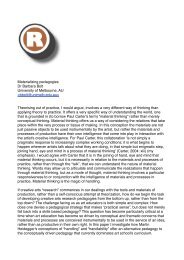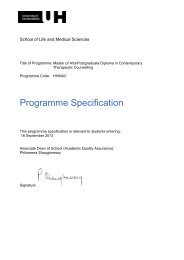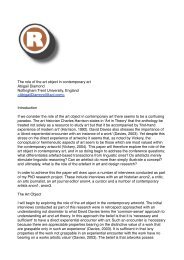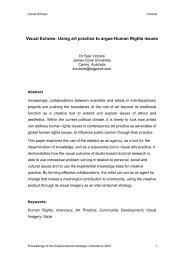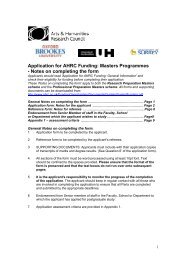Is the law effective in protecting market s from insider trading?
Is the law effective in protecting market s from insider trading?
Is the law effective in protecting market s from insider trading?
You also want an ePaper? Increase the reach of your titles
YUMPU automatically turns print PDFs into web optimized ePapers that Google loves.
Hertfordshire Law Journal 3( 2), 2-17ISSN 1479-4195 Onl<strong>in</strong>e / ISSN 1479-4209 CDRom2<strong>Is</strong> <strong>the</strong> <strong>law</strong> <strong>effective</strong> <strong>in</strong> protect<strong>in</strong>g <strong>market</strong>s <strong>from</strong> <strong>in</strong>sider trad<strong>in</strong>g?Dr Georgios I Zekos*IntroductionInsider trad<strong>in</strong>g is a term of art commonly mean<strong>in</strong>g, or referr<strong>in</strong>g to, illegitimate trad<strong>in</strong>g bysomeone, whe<strong>the</strong>r or not <strong>the</strong> person is a true corporate <strong>in</strong>sider, possess<strong>in</strong>g material,nonpublic <strong>in</strong>formation about publicly traded securities. 1 In o<strong>the</strong>r words, <strong>in</strong>sider trad<strong>in</strong>g isbuy<strong>in</strong>g or sell<strong>in</strong>g shares or any o<strong>the</strong>r k<strong>in</strong>d of securities while <strong>in</strong> possession of unpublished<strong>in</strong>formation about <strong>the</strong> issuer or <strong>the</strong> trad<strong>in</strong>g of <strong>the</strong>se shares. Insider trad<strong>in</strong>g <strong>in</strong>volvespersons <strong>in</strong> positions of power who use nonpublic <strong>in</strong>formation that is ga<strong>in</strong>ed <strong>from</strong> <strong>the</strong>ircorporate stand<strong>in</strong>g to serve <strong>the</strong>ir own f<strong>in</strong>ancial <strong>in</strong>terests or, at times, <strong>the</strong> f<strong>in</strong>ancial <strong>in</strong>terestsof <strong>the</strong>ir clients, family, or friends. Insider trad<strong>in</strong>g is most frequently done <strong>in</strong> order toamass profits by trad<strong>in</strong>g <strong>in</strong> advance of takeover announcements. Information is“material” if it would be important for an <strong>in</strong>vestor to have <strong>in</strong> decid<strong>in</strong>g whe<strong>the</strong>r to sell orpurchase a security. Crim<strong>in</strong>aliz<strong>in</strong>g <strong>in</strong>sider trad<strong>in</strong>g is central to <strong>the</strong> policies of promot<strong>in</strong>g<strong>in</strong>vestor confidence and <strong>the</strong> fundamental fairness to <strong>market</strong> participants and <strong>the</strong>uprightness of <strong>the</strong> securities <strong>market</strong> depends on <strong>in</strong>vestor confidence. 2 Without <strong>in</strong>vestorconfidence <strong>in</strong>vestors would decl<strong>in</strong>e to take part <strong>in</strong> <strong>the</strong> <strong>market</strong>s at all. It could be arguedthat a transaction with an <strong>in</strong>sider trader results <strong>in</strong> an <strong>in</strong>vestor’ trad<strong>in</strong>g at <strong>the</strong> wrong priceand <strong>the</strong> price at which an <strong>in</strong>vestor trades does not reflect <strong>the</strong> undisclosed <strong>in</strong>formation<strong>in</strong>duc<strong>in</strong>g an <strong>in</strong>vestor to make an ill-advised transaction. Does <strong>in</strong>sider trad <strong>in</strong>g deter small<strong>in</strong>vestors <strong>from</strong> participat<strong>in</strong>g because <strong>the</strong>y would feel <strong>the</strong> play<strong>in</strong>g field is not level? 3 Theideal is a <strong>market</strong> <strong>in</strong> which prices provide accurate signals for resource allocation.An <strong>effective</strong> securities regulatory framework offers a vision to <strong>the</strong> <strong>in</strong>vestor of fairness <strong>in</strong><strong>the</strong> <strong>market</strong> place. This should be accomplished through <strong>in</strong>creased disclosure, additionalmonitor<strong>in</strong>g of requirements for <strong>in</strong>vestment bus<strong>in</strong>esses and <strong>effective</strong> and vigorousprosecution of securities <strong>law</strong> violations. Moreover, this vision should be based uponpositive macro and micro economic factors of a strong economy function<strong>in</strong>g <strong>in</strong> achangeable <strong>in</strong>ternational <strong>market</strong>. Can state regulations by <strong>the</strong>mselves susta<strong>in</strong> a healthysecurities <strong>market</strong>? The relations between those who f<strong>in</strong>ance <strong>in</strong>dustry and those whomanage it should be harmonious. There is a conflict between harmonious relations and<strong>the</strong> objective or equal <strong>in</strong>formation for all. The traditional rationale articulated for <strong>in</strong>sider* BSc(Econ), J.D, LLM, PhD, Attorney at <strong>law</strong>-Economist, Greece zekosg@yahoo.com1 Symposium, Insider Trad<strong>in</strong>g: Law, Policy, and Theory After O’Hagan, 20 CARDOZO L. REV. 7, 9(1998).2United States v. O’Hagan, 521 U.S. 6423 Timothy M. Wong, United States v. O’Hagan: SEC prevails on Misappropriation Theory, Yet May NowFace Heightened Standard of Proof for Securities Insider Trad<strong>in</strong>g, 32 U.S.F. L. REV. 841, 843 (1998).Michael J. Voves, United States v. O’Hagan: Improperly Incorporat<strong>in</strong>g Common Law FiduciaryObligations <strong>in</strong>to 14(e) of <strong>the</strong> Securities Exchange Act, 81 MINN. L. REV. 10 15, 1021 (1997).Dr Georgios I ZekosThe moral rights of <strong>the</strong> author have been asserted.Database rights The Centre for International Law (maker).
Hertfordshire Law Journal 3( 2), 2-17ISSN 1479-4195 Onl<strong>in</strong>e / ISSN 1479-4209 CDRom3trad<strong>in</strong>g regulation and o<strong>the</strong>r securities <strong>law</strong> is that such rules promote confidence <strong>in</strong><strong>market</strong>s. Scholars have argued that permitt<strong>in</strong>g trade on <strong>the</strong> basis of <strong>in</strong>side <strong>in</strong>formationcreates desirable <strong>in</strong>centives and improves economic efficiency. 4Professor Roberta Romano 5 has called for <strong>the</strong> <strong>in</strong>troduction for a system of competitivefederalism for securities regulation. In accordance with Romano’s view a publiccorporation’s coverage under <strong>the</strong> national securities <strong>law</strong>s must be optional ra<strong>the</strong>r thanmandatory and <strong>the</strong> securities transactions of a corporation that chooses not to be coveredby <strong>the</strong> federal securities <strong>law</strong>s are to be regulated by <strong>the</strong> corporation’s selected domicilefor securities regulation. On <strong>the</strong> one hand, regulatory competition might sound as a goodidea because <strong>the</strong> choice of <strong>in</strong>vestments <strong>in</strong>cludes variation <strong>in</strong> legal regimes. Firms willf<strong>in</strong>d that <strong>the</strong>y can obta<strong>in</strong> a lower cost of capital by choos<strong>in</strong>g <strong>the</strong> regime that <strong>in</strong>vestorsprefer. Hence, promoters will select <strong>the</strong> regime that maximises <strong>the</strong> jo<strong>in</strong>t <strong>in</strong>terests ofpromoters and <strong>in</strong>vestors. On <strong>the</strong> o<strong>the</strong>r hand, <strong>the</strong> competitive federalism does notelim<strong>in</strong>ate <strong>the</strong> possibility of mandatory rules and practises to be endorsed with<strong>in</strong> <strong>the</strong>competitive securities regimes. The detection of manipulation of prices, fraud and <strong>in</strong>sidertrad<strong>in</strong>g might become more difficult to be detected. It has to be taken <strong>in</strong>to account that<strong>the</strong> existence of competition or competition rules does not mean that <strong>the</strong>re is not ei<strong>the</strong>rabuse of a dom<strong>in</strong>ant position or abuse of <strong>the</strong> competition rules <strong>the</strong>mselves. In acompetitive regulatory regime undesirable mandatory policies cannot be ma<strong>in</strong>ta<strong>in</strong>ed overtime because firms will migrate to a regulatory regime that does not impose suchmandates. However, an easy migration <strong>from</strong> a regulatory regime to a less strict regulatorysystem does not secure <strong>the</strong> <strong>in</strong>vestors position tak<strong>in</strong>g <strong>in</strong>to account <strong>the</strong> volatility and <strong>the</strong>characteristics of <strong>the</strong> securities <strong>market</strong>. Litigation <strong>in</strong> a changeable legal regime might be aburden for <strong>in</strong>dividual <strong>in</strong>vestors. Competition would not elim<strong>in</strong>ate merit regulation butra<strong>the</strong>r would preserve it. Investors will choose <strong>the</strong> regime that protects <strong>the</strong>ir f<strong>in</strong>ancial<strong>in</strong>terests. In fact, <strong>the</strong> commercial demands of a national <strong>market</strong> would press toward4 What k<strong>in</strong>d of relationships trigger liability for <strong>in</strong>sider trad<strong>in</strong>g based on <strong>the</strong> Misappropriation Theory? TheMisappropriation Theory has failed to def<strong>in</strong>e what k<strong>in</strong>ds of relationships trigger liability for <strong>in</strong>sider trad<strong>in</strong>g.The courts have failed to dist<strong>in</strong>guish <strong>the</strong> legal basis for <strong>the</strong> fiduciary duty analysis. There is a need toarticulate, <strong>in</strong> detail, <strong>the</strong> parameters of <strong>the</strong> fiduciary duties that give rise to Rule 10b-5 liability under <strong>the</strong>Misappropriation Theory. Recently, <strong>the</strong> SEC promulgated Rule 10b5-2 sett<strong>in</strong>g forth three situations <strong>in</strong>which a person owes a duty of trust or confidence under <strong>the</strong> Misappropriation Theory. Insider trad<strong>in</strong>gprosecutions have shifted to lower level corporate fiduciaries and <strong>the</strong>ir friends and families. Insider trad<strong>in</strong>glegislation is necessary as part of a well-function<strong>in</strong>g corporate governance regime s<strong>in</strong>ce small <strong>in</strong>vestors willo<strong>the</strong>rwise be unprotected. Whereas Rule 10b-5 imposes a duty to disclose on managers, it does notnecessarily impose a similar duty on outside shareholders who do not owe a fiduciary duty to smallershareholders. While European <strong>law</strong> seems to rely on a narrower def<strong>in</strong>ition of <strong>in</strong>side <strong>in</strong>formation, it seems tobe wider <strong>in</strong> its coverage of company outsiders who may be liable as “tippees ”, which would also impose aliability on a dom<strong>in</strong>ant shareholder who learns adverse <strong>in</strong>formation about <strong>the</strong> company through <strong>in</strong>directsources. Consequently, while European <strong>law</strong> seems to be unduly narrow with respect to what constitutes<strong>in</strong>side <strong>in</strong>formation, it is arguably more comprehensive with respect to who is an <strong>in</strong>sider. Directive2003/6/EC of <strong>the</strong> European Parliament and of <strong>the</strong> Council of 28 January 2003 on <strong>in</strong>sider deal<strong>in</strong>g and<strong>market</strong> manipulation (<strong>market</strong> abuse) replaces Council Directive 89/592/EEC. Official Journal L 096 ,12/04/2003 P. 0016 – 0025. Bhattacharya, U, Daouk, H.,2002. The world price of <strong>in</strong>sider trad<strong>in</strong>g. Journalof F<strong>in</strong>ance 57, 75 – 108. Bhattacharya, S, Nicodano, G.,2001. Insider trad<strong>in</strong>g, <strong>in</strong>vestment, and liquidity: Awelfare analysis. Journal of F<strong>in</strong>ance 56, pp.1141 –1156.5[1997] Yale LJ 1326.Dr Georgios I ZekosThe moral rights of <strong>the</strong> author have been asserted.Database rights The Centre for International Law (maker).
Hertfordshire Law Journal 3( 2), 2-17ISSN 1479-4195 Onl<strong>in</strong>e / ISSN 1479-4209 CDRom4uniformity despite <strong>the</strong> <strong>in</strong>consequential effect of variety. Does <strong>in</strong>sider trad<strong>in</strong>g lead to moreaccurate prices ra<strong>the</strong>r than any strict regulation aga<strong>in</strong>st it?Accord<strong>in</strong>g to Carlton and Fischel 6 <strong>in</strong>sider trad<strong>in</strong>g is efficient and public regulation is<strong>in</strong>efficient. Besides, Georgakopoulos 7 argues <strong>the</strong> opposite. Are differences <strong>in</strong> specificlegal elements of countries’ <strong>in</strong>sider trad<strong>in</strong>g <strong>law</strong>s associated with differences <strong>in</strong> <strong>the</strong>structure and performance of <strong>the</strong>ir stock <strong>market</strong>s? Deterrent elements of formal <strong>in</strong>sidertrad<strong>in</strong>g <strong>law</strong>s matter to stock <strong>market</strong> development. Are <strong>law</strong>s of <strong>in</strong>sider trad<strong>in</strong>g <strong>effective</strong> <strong>in</strong>discourag<strong>in</strong>g <strong>in</strong>siders <strong>from</strong> trad<strong>in</strong>g on non-public <strong>in</strong>formation? The aim of this analysiswill be to exam<strong>in</strong>e <strong>the</strong> <strong>effective</strong>ness of <strong>the</strong> legal regulation.The Role of <strong>the</strong> Security MarketThe primary purpose of a security <strong>market</strong> is to facilitate <strong>the</strong> transfer of sav<strong>in</strong>gs <strong>from</strong>surplus units wish<strong>in</strong>g to <strong>in</strong>vest to deficit units wish<strong>in</strong>g to borrow and desired changes <strong>in</strong><strong>the</strong> asset structure of <strong>in</strong>vestors. One of <strong>the</strong> most important economic advantages of equityf<strong>in</strong>anc<strong>in</strong>g is that funds obta<strong>in</strong>ed by issu<strong>in</strong>g stock are credits of unlimited duration, while<strong>the</strong> <strong>in</strong>dividual <strong>in</strong>vestor’s commitment is not long term. A liquid <strong>market</strong> is one thatenables an <strong>in</strong>vestor to dispose of his shares without undue delay and withoutunreasonable loss as well. Frequent sales, ease of transaction prices and reasonably stableprice fluctuations over time are characteriz<strong>in</strong>g a stock <strong>market</strong>. A liquid <strong>market</strong> has to beboth active and stable. Hence, public confidence creates will<strong>in</strong>gness to purchase shares,while public distrust creates reluctance to <strong>in</strong>vest <strong>in</strong> security <strong>market</strong>s, mostly by small<strong>in</strong>vestors. A certa<strong>in</strong> degree of volatility is unavoidable because stock price fluctuation<strong>in</strong>dices chang<strong>in</strong>g values across economic activities so resources can be better allocated.Besides, excessive volatility dim<strong>in</strong>ishes and impedes resource allocation. 8 Legal ruleshave not managed to elim<strong>in</strong>ate <strong>market</strong> volatility, which means that <strong>the</strong> fundamental rolebelongs to economic factors ra<strong>the</strong>r than <strong>law</strong>. Can <strong>in</strong>sider trad<strong>in</strong>g raise price volatility <strong>in</strong><strong>the</strong> long run and reduce economic efficiency? Access to <strong>in</strong>side <strong>in</strong>formation is morevaluable when <strong>the</strong>re is a big rise or a big fall <strong>in</strong> prices. Insiders choose riskier projectsthan <strong>the</strong>y o<strong>the</strong>rwise would and manipulate <strong>the</strong> tim<strong>in</strong>g and content of <strong>the</strong> <strong>in</strong>formationrelease <strong>in</strong> a way that generate more volatility than it o<strong>the</strong>rwise would. Fur<strong>the</strong>r <strong>in</strong>sidertrad<strong>in</strong>g is found to be associated with higher <strong>market</strong> volatility, volatility of monetary andfiscal policies and maturity of <strong>the</strong> stock <strong>market</strong>. 9 Consequently, economic factors arethose <strong>in</strong>fluenc<strong>in</strong>g <strong>in</strong>sider trad<strong>in</strong>g ra<strong>the</strong>r than <strong>the</strong> legal order.The Market Price and Insider Trad<strong>in</strong>g6 Carlton, Dennis W. and Daniel R. Fischel, 1983. “The Regulation of Insider Trad<strong>in</strong>g,” 35 Stanford LawReview 857-895.7Georgakopoulos, Nicholas L. 1993. “Insider Trad<strong>in</strong>g as a Transactional Cost: A Market MicrostructureJustification and Optimization of Insider Trad<strong>in</strong>g Regulation,” 26 Connecticut Law Review 1-51.8R Shiller, 1981, Do stock prices move too much to be justified by changes <strong>in</strong> subsequent dividend?,American Economic Review No 3 421-36.9J Du, S Wei, Does <strong>in</strong>sider trad<strong>in</strong>g raise <strong>market</strong> volatility? IMF Work<strong>in</strong>g Paper WP/03/51.Dr Georgios I ZekosThe moral rights of <strong>the</strong> author have been asserted.Database rights The Centre for International Law (maker).
Hertfordshire Law Journal 3( 2), 2-17ISSN 1479-4195 Onl<strong>in</strong>e / ISSN 1479-4209 CDRom5Economists believe that <strong>in</strong>sider trad<strong>in</strong>g ensures that <strong>the</strong> <strong>market</strong> price of affected securitiesmoves <strong>in</strong> <strong>the</strong> appropriate direction. 10 Subsequently, a securities <strong>market</strong> with active<strong>in</strong>siders ensures accuracy <strong>in</strong> <strong>the</strong> pric<strong>in</strong>g of <strong>the</strong> secur ities so traded. Insider trad<strong>in</strong>g movesprices towards a level, which correctly reflects <strong>the</strong> actual position of a company at agiven po<strong>in</strong>t <strong>in</strong> time. Individuals may be less likely to seek to acquire corporate<strong>in</strong>formation if a prohibition aga<strong>in</strong>st <strong>in</strong>sider trad<strong>in</strong>g may prevent <strong>the</strong>m <strong>from</strong> mak<strong>in</strong>g use ofit. In many cases <strong>the</strong> disclosure of any <strong>in</strong>formation would have occurred regardless of anyrelated <strong>in</strong>sider trad<strong>in</strong>g. It is <strong>the</strong>refore unclear whe<strong>the</strong>r permitt<strong>in</strong>g <strong>in</strong>sider trad<strong>in</strong>g per sewould be likely to have much effect on <strong>the</strong> accuracy of share values.Price pressure is <strong>the</strong> key to <strong>the</strong> argument that <strong>in</strong>sider trad<strong>in</strong>g improves <strong>the</strong> efficiency of<strong>the</strong> securities <strong>market</strong>. Insider trad<strong>in</strong>g <strong>in</strong> shares is often accompanied by a significantchange <strong>in</strong> its <strong>market</strong> price, which <strong>in</strong>dicates price pressure. On <strong>the</strong> o<strong>the</strong>r hand if <strong>the</strong>demand is perfectly elastic, <strong>in</strong>sider buy<strong>in</strong>g or sell<strong>in</strong>g is <strong>in</strong>capable of shift<strong>in</strong>g prices. Therise of stock prices preceded on announcement of a merger or tender offer of a premiumprice resulted not only <strong>from</strong> <strong>in</strong>sider trad<strong>in</strong>g but also <strong>from</strong> <strong>the</strong> <strong>market</strong>’s anticipation of <strong>the</strong>upcom<strong>in</strong>g bid and <strong>in</strong>corporatio n of <strong>the</strong> <strong>in</strong>formation <strong>in</strong>to share prices. Abnormal pricesbuilt up by <strong>the</strong> participant’s overestimation of <strong>the</strong> value of <strong>the</strong> assets of <strong>the</strong> company.Insider trad<strong>in</strong>g moves prices because outsiders decode <strong>in</strong>formation <strong>from</strong> <strong>the</strong> fact of <strong>the</strong>trad<strong>in</strong>g itself. It could be argued that <strong>the</strong> mechanism of economy moves <strong>the</strong> prices to <strong>the</strong>correct level ra<strong>the</strong>r than any regulatory <strong>law</strong>.Accurate pric<strong>in</strong>g can be set by <strong>the</strong> <strong>market</strong> if all <strong>in</strong>formation relat<strong>in</strong>g to <strong>the</strong> security hasbeen publicly disclosed. This benefits society by improv<strong>in</strong>g <strong>the</strong> economy’s allocation ofcapital <strong>in</strong>vestment and by decreas<strong>in</strong>g <strong>the</strong> volatility of security prices. The <strong>market</strong> reactsfairly quickly when <strong>in</strong>siders buy securities, but <strong>the</strong> <strong>in</strong>itial price effect is small when<strong>in</strong>siders sell. 11 The price effects of <strong>in</strong>sider trad<strong>in</strong>g <strong>in</strong>duce shareholders to make poorlyadvised transactions. Price or volume changes result<strong>in</strong>g <strong>from</strong> <strong>in</strong>sider trad<strong>in</strong>g will hardlyever be of sufficient magnitude to encourage <strong>in</strong>vestors to trade. 12 The publicity given toscandals put all <strong>in</strong>vestors on notice that <strong>in</strong>sider trad<strong>in</strong>g is a common securities violation,which means that <strong>in</strong>sider trad<strong>in</strong>g does not threaten <strong>the</strong> confidence of <strong>in</strong>vestors <strong>in</strong> <strong>the</strong>securities <strong>market</strong>s. 13 Moreover, regardless of all legal rules <strong>in</strong>sider trad<strong>in</strong>g still happensand this knowledge drives prices to <strong>the</strong> right level.It could be argued that <strong>in</strong>sider trad<strong>in</strong>g becomes a source of <strong>in</strong>jury to <strong>the</strong> firm if it creates<strong>in</strong>centives for managers to hold-up <strong>the</strong> transmission of <strong>in</strong>formation to superiors. Even if10 H Wu “ An Economist looks at section 16 of <strong>the</strong> Securities Exchange Act of 1934” 1966 Columbia LR26011 F<strong>in</strong>nerty, Joseph E. (1976), ‘Insiders and Market Efficiency’, 31 Journal of F<strong>in</strong>ance, 1141-1148.12 Gilson, Ronald J. and Kraakman, Re<strong>in</strong>ier H. (1984), ‘The Mechanisms of Market Efficiency’, 70Virg<strong>in</strong>ia Law Review, 549-644.13Macey, Jonathan R. (1984), ‘From Fairness to Contract: The New Direction of <strong>the</strong> Rules Aga<strong>in</strong>st InsiderTrad<strong>in</strong>g’, 13 Hofstra Law Review, 9-64. Macey, Jonathan R. (1988), ‘Ethics, Economics, and InsiderTrad<strong>in</strong>g: Ann Rand Meets <strong>the</strong> Theory of <strong>the</strong> Firm’, 11 Harvard Journal of Law and Public Policy, 785-804. Macey, Jonathan R. (1988), ‘From Judicial Solutions to Political Solutions: The New, New Directionof <strong>the</strong> Rules Aga<strong>in</strong>st Insider Trad<strong>in</strong>g’, 39 Alabama Law Review, 355-380.Dr Georgios I ZekosThe moral rights of <strong>the</strong> author have been asserted.Database rights The Centre for International Law (maker).
Hertfordshire Law Journal 3( 2), 2-17ISSN 1479-4195 Onl<strong>in</strong>e / ISSN 1479-4209 CDRom7participation means that mass psychology <strong>in</strong>fluences stock prices and <strong>the</strong>ir fluctuation.The task of speculators for a quick profit depends upon <strong>the</strong> <strong>in</strong>fluence of speculation uponmass psychology ra<strong>the</strong>r than future changes of underly<strong>in</strong>g factors <strong>in</strong> <strong>the</strong> <strong>market</strong>.Accord<strong>in</strong>gly, share prices reflect mass psychology ra<strong>the</strong>r than provid<strong>in</strong>g <strong>in</strong>formation <strong>in</strong><strong>the</strong> <strong>market</strong> for allocational and promotional purposes. However, <strong>in</strong>formed <strong>in</strong>siderspeculators can forecast future prices and make profits speculat<strong>in</strong>g when <strong>the</strong>y are able touse <strong>the</strong>ir <strong>in</strong>side <strong>in</strong>formation to <strong>the</strong>ir advantage. It is supposed that <strong>the</strong> public is notreact<strong>in</strong>g irrationally by mass psychology. Hence, <strong>in</strong> time of crisis irrational masspsychology becomes important. What about a short-term crisis, which is createdtechnically? It is assumed that speculators can foresee <strong>the</strong> normal price of shares, whichnarrows <strong>the</strong> range of fluctuations. It could be argued that a stock <strong>market</strong> considered safe<strong>from</strong> <strong>in</strong>sider trad<strong>in</strong>g is <strong>the</strong> arena for mass <strong>in</strong>sider trad<strong>in</strong>g ga<strong>in</strong>s by technical f<strong>in</strong>ancialcrisis. Outsiders can easily follow <strong>the</strong>ir <strong>market</strong> behaviour and so a public speculativedema nd may destabilize prices fur<strong>the</strong>r. In <strong>the</strong> long run <strong>the</strong> efficient operation of capital<strong>market</strong>s and a properly function<strong>in</strong>g economy is <strong>the</strong> best protection for <strong>in</strong>vestors. In <strong>the</strong>short run basically organized <strong>market</strong>s stimulate <strong>in</strong>vestors towards <strong>in</strong>vestment and quickprofit. Can any legislator deal with speculation <strong>effective</strong>ly ra<strong>the</strong>r than leav<strong>in</strong>g <strong>the</strong> <strong>market</strong>to deal with and solve <strong>the</strong> problem? The author considers that basic legal rules are <strong>the</strong>basis for a normal runn<strong>in</strong>g of a stock exchange and a properly runn<strong>in</strong>g economy is <strong>the</strong>axis for a proper function<strong>in</strong>g of a stock exchange, which can absorb a normal level of<strong>in</strong>sider trad<strong>in</strong>g.The Role of InformationResearch has shown a positive, moderate relationship between public <strong>in</strong>formation andtrad<strong>in</strong>g volume, but an <strong>in</strong>significant relationship with price volatility. 20 Thus, <strong>in</strong>vestorsseem not to be affected by public <strong>in</strong>formation <strong>in</strong> contrast with a reaction under heavyspeculation. On <strong>the</strong> o<strong>the</strong>r hand <strong>in</strong> efficient <strong>market</strong>s, stock price reaction is expected tooccur at <strong>the</strong> time <strong>in</strong>formation becomes public. Practice has shown that <strong>in</strong>sider sell<strong>in</strong>gdoes <strong>in</strong> fact <strong>in</strong>crease significantly as <strong>the</strong> bankruptcy announcement approached. 21Insiders, us<strong>in</strong>g unpublished <strong>in</strong>formation to <strong>the</strong>ir advantage, have been able to generateabnormal returns trad<strong>in</strong>g <strong>in</strong> <strong>the</strong>ir shares. Besides, non <strong>in</strong>siders may be able to participate<strong>in</strong> <strong>the</strong>se profits by us<strong>in</strong>g <strong>the</strong> <strong>in</strong>formation. Additionally, most of <strong>the</strong> time <strong>the</strong> expertise andknowledge of <strong>the</strong> <strong>in</strong>sider leads to a better evaluation of <strong>the</strong> <strong>in</strong>formation, which drives<strong>in</strong>siders to have a better use of <strong>the</strong> <strong>in</strong>formation ra<strong>the</strong>r than <strong>the</strong> unpublished <strong>in</strong>formation,because an expert can evaluate with precision <strong>the</strong> real status of a company us<strong>in</strong>g <strong>the</strong>published f<strong>in</strong>gers <strong>in</strong> comb<strong>in</strong>ation with <strong>the</strong> status of <strong>the</strong> specific <strong>market</strong>. Fur<strong>the</strong>rmore,un<strong>in</strong>formed outsiders can earn significant abnormal profits by imitat<strong>in</strong>g <strong>in</strong>siders.Outsiders can purchase or sell follow<strong>in</strong>g an <strong>in</strong>sider’s stock purchases.20T Bery, K Howe “Public Information Arrival “ 1994 The Journal of F<strong>in</strong>ance 1331. C Tighe “ ThePolitical Economy of Insider trad<strong>in</strong>g Laws” 1994 The American Economic Review 16421T Cosnell “ Bankruptcy and <strong>in</strong>sider trad<strong>in</strong>g” 1992 The Journal of F<strong>in</strong>ance 349Dr Georgios I ZekosThe moral rights of <strong>the</strong> author have been asserted.Database rights The Centre for International Law (maker).
Hertfordshire Law Journal 3( 2), 2-17ISSN 1479-4195 Onl<strong>in</strong>e / ISSN 1479-4209 CDRom8Trad<strong>in</strong>g by <strong>in</strong>vestors who posses superior <strong>in</strong>formation imposes significant liquidity costson o<strong>the</strong>r <strong>market</strong> participants due to adverse selection. 22 Accord<strong>in</strong>g to Huffan 23 <strong>the</strong> valueof trade, as well as <strong>the</strong> price of capital, can be highly correlated with a measure of <strong>the</strong><strong>in</strong>formation content of prices. Can any regulation measure <strong>the</strong> quality of <strong>in</strong>formation andenforce <strong>the</strong> quality on <strong>in</strong>formation? The stock <strong>market</strong> detects <strong>the</strong> possibility of <strong>in</strong>formedtrad<strong>in</strong>g and impounds this <strong>in</strong>formation <strong>in</strong>to <strong>the</strong> stock price. It could be said that <strong>the</strong><strong>market</strong> mechanism detects <strong>in</strong>sider <strong>in</strong>formation and absorbs it ra<strong>the</strong>r than any <strong>law</strong>. Ifparticipants know <strong>the</strong> probability that <strong>in</strong>sider trad<strong>in</strong>g will affect <strong>the</strong> price of shares, <strong>the</strong>ywill adjust <strong>the</strong>ir behaviour to avoid overpay<strong>in</strong>g. Information such as <strong>the</strong> <strong>in</strong>tention to bidfor control of a target firm is not reflected <strong>in</strong> <strong>the</strong> <strong>market</strong> price of <strong>the</strong> target shares until anaction occurs that causes many traders to <strong>in</strong>fer that <strong>in</strong>formation. Unusual trad<strong>in</strong>g volumeattracts attention <strong>from</strong> securities traders and of course public statements provide direct<strong>in</strong>formation about potential bids.While <strong>in</strong>sider trad<strong>in</strong>g reduces <strong>the</strong> risk created by <strong>in</strong>accurate stock pric<strong>in</strong>g, it <strong>in</strong>creases <strong>the</strong>risk to <strong>the</strong> <strong>in</strong>sider who receives trad<strong>in</strong>g rights <strong>in</strong> place of o<strong>the</strong>r apparently more secureforms of compensation distort<strong>in</strong>g <strong>the</strong> flow of <strong>in</strong>formation to <strong>in</strong>vestors. This is because<strong>in</strong>siders time <strong>the</strong> flow of <strong>in</strong>formation to make <strong>the</strong> most of trad<strong>in</strong>g ga<strong>in</strong>s and discourag<strong>in</strong>g<strong>the</strong> flow of <strong>in</strong>formation with<strong>in</strong> a firm. 24 Information shar<strong>in</strong>g <strong>in</strong>creases <strong>the</strong> number of<strong>in</strong>siders who trade on non-public <strong>in</strong>formation; <strong>in</strong>creased trad<strong>in</strong>g affect share price andconsequently dim<strong>in</strong>ishes profits to each <strong>in</strong>sider, affects resource allocation with<strong>in</strong> acompany because managers are encouraged to decide on those projects that maximizeprospective trad<strong>in</strong>g ga<strong>in</strong>s. 25 It could be said that <strong>in</strong> limited circumstances allow<strong>in</strong>gmanagers to trade may better impound <strong>in</strong>formation about hidden managerial action. 26Risky projects offer more potential trad<strong>in</strong>g profits than safe projects and <strong>the</strong> <strong>in</strong>sider isable to trade before knowledge of <strong>the</strong> project’s outcome reaches <strong>the</strong> public distract<strong>in</strong>gexecutives <strong>from</strong> o<strong>the</strong>r firm bus<strong>in</strong>ess and distort<strong>in</strong>g managerial behavio ur.22 R Benabou “Us<strong>in</strong>g privileged <strong>in</strong>formation to manipulate <strong>market</strong>s: <strong>in</strong>siders, curus and credibility” 1992Quarterly Journal of Economics 921. M Brennan “ Investment analysis and price formation <strong>in</strong> securities<strong>market</strong>s” 1995 Journal of F<strong>in</strong>ancial Economics 36123 G Huffman “ Information, asset prices and <strong>the</strong> volume of trade “ 1992 The Journal of F<strong>in</strong>ance 157524 Jesse M. Fried, Reduc<strong>in</strong>g <strong>the</strong> Profitability of Corporate Insider Trad<strong>in</strong>g Through Pretrad<strong>in</strong>g Disclosure,71 S. CAL. L. REV. 303 (1998). Fried advocates supplement<strong>in</strong>g Rule 10b-5 restrictions with a regime ofpretrad<strong>in</strong>g disclosure. Frank H. Easterbrook, Insider Trad<strong>in</strong>g, Secret Agents, Evidentiary Privileges, and<strong>the</strong> Production of Information, 198 1 SUP. CT. REV 309, 332 (1981); Kenneth E. Scott, Insider Trad<strong>in</strong>g:Rule 10b-5, Disclosure and Corporate Privacy, 9 J. LEG. STUD. 801, 808 (1980). Easterbrook, supra note108, at 333; Paul E. Fischer, Optimal Contract<strong>in</strong>g and Insider Trad<strong>in</strong>g Restriction s, 47 J. FIN. 673 (1992).Robert J. Haft, The Effect of Insider Trad<strong>in</strong>g Rules on <strong>the</strong> Internal Efficiency of <strong>the</strong> Large Corporation, 80MICH. L. REV. 1051 (1982). Saul Levmore, Securities and Secrets: Insider Trad<strong>in</strong>g and <strong>the</strong> Law ofContracts, 68 VA. L. REV. 117, 149 (1982). Ronald J. Gilson & Re<strong>in</strong>ier H. Kraakman, The Mechanisms ofMarket Efficiency, 70 VA. L. REV. 549 (1984).25 Jonathan R. Macey, Securities Trad<strong>in</strong>g: A Contractual Perspective, 50 CASE W. RES. L. REV. 269(1999).26 Jie Hu & Thomas H. Noe, Insider Trad<strong>in</strong>g and Managerial Incentives, 25 J. BANKING & FIN. 681(2001)Dr Georgios I ZekosThe moral rights of <strong>the</strong> author have been asserted.Database rights The Centre for International Law (maker).
Hertfordshire Law Journal 3( 2), 2-17ISSN 1479-4195 Onl<strong>in</strong>e / ISSN 1479-4209 CDRom9It could be said that <strong>in</strong>sider trad<strong>in</strong>g violates procedural equality and fairness ofopportunity. 27 Insiders can make abnormal profits <strong>in</strong> <strong>the</strong> stock <strong>market</strong>. Outsiders whomimic <strong>the</strong> <strong>in</strong>formation of <strong>in</strong>sider trades can earn abnormal profits as well. Insider trad<strong>in</strong>gcan lead to more <strong>in</strong>formative prices. Insider sell<strong>in</strong>g is more active when <strong>the</strong>re are stockprice run-ups and it <strong>the</strong>n correct prices significantly. 28 Hence, <strong>in</strong>sider trad<strong>in</strong>g conveysmore <strong>in</strong>formation to <strong>the</strong> <strong>market</strong>, which means more pragmatic share prices. 29Management and Insider Trad<strong>in</strong>gProfessor Henry Manne 30 argued that <strong>in</strong>sider trad<strong>in</strong>g contributes to greater efficiency <strong>in</strong>stock <strong>market</strong> pric<strong>in</strong>g because <strong>in</strong>formation becomes embedded <strong>in</strong> stock prices morequickly than it would if <strong>in</strong>siders waited until such <strong>in</strong>formation was ripe for disclosure.Fur<strong>the</strong>r, <strong>the</strong> profits made by <strong>in</strong>siders on such trades are an appropriate reward for <strong>the</strong>irlabor. Additionally, Manne argued that <strong>in</strong>sider trad<strong>in</strong>g is an efficient way ofcompensat<strong>in</strong>g managers for hav<strong>in</strong>g produced <strong>in</strong>formation which means that <strong>the</strong> companybenefits directly and society ultimately because managers have a greater <strong>in</strong>centive toproduce additional <strong>in</strong>formation of value to <strong>the</strong> company. First, allow<strong>in</strong>g such trad<strong>in</strong>gwould encourage <strong>in</strong>siders to manipulate corporate decision-mak<strong>in</strong>g and withhold<strong>in</strong>formation <strong>from</strong> <strong>the</strong> <strong>market</strong>. In contrast, prohibit<strong>in</strong>g <strong>in</strong>sider trad<strong>in</strong>g removes animpediment to <strong>the</strong> prompt release of <strong>in</strong>formation and promotes economic efficiency byassur<strong>in</strong>g that share prices reflect <strong>the</strong>ir true value. Such <strong>in</strong>formational efficiency assuresthat capital is allocated efficiently. Also, permitt<strong>in</strong>g <strong>in</strong>sider trad<strong>in</strong>g would discourageresearch and analysis because <strong>the</strong> public <strong>in</strong>formation available to an analyst would notreflect all of <strong>the</strong> facts upon which trad<strong>in</strong>g is occurr<strong>in</strong>g. 31 Stock-based compensation might27 Salbu, S.: 1995, ‘Insider Trad<strong>in</strong>g and <strong>the</strong> Social Contract’, Bus<strong>in</strong>ess Ethics Quarterly 5, 313–328.28Gompers, P. and Lerner, J. (1999) Venture capital distributions: Short -run and long-run reactions, J.F<strong>in</strong>ance 53, 621–649.29Rozeff, M. S. and Zaman, M. A. (1998) Overreaction and <strong>in</strong>sider trad<strong>in</strong>g: Evidence <strong>from</strong> growth andvalue portfolios, J. F<strong>in</strong>ance 53, 701– 716.30 Dennis W. Carlton & Daniel R. Fischel, The Regulation of Insider Trad<strong>in</strong>g, 35 STAN. L. REV. 857(1983); Frank H. Easterbrook, Insider Trad<strong>in</strong>g, Secret Agents, Evidentiary Privileges, and <strong>the</strong> Productionof Information, 1981 SUP. CT. REV. 309; Jill E. Fisch, Start Mak<strong>in</strong>g Sense: An Analysis and Proposal forInsider Trad<strong>in</strong>g Regulation, 26 GA. L. REV. 179 (1991). See also Donald C. Langevoort, Insider Trad<strong>in</strong>gRegulation, Enforcement and Prevention (1991); Henry G. Manne, Insider Trad<strong>in</strong>g and <strong>the</strong> Stock Market(1966); William K.S. Wang & Marc I. Ste<strong>in</strong>berg Insider Trad<strong>in</strong>g (1996).31 Robert J. Haft, The Effect of Insider Trad<strong>in</strong>g Rules on <strong>the</strong> Internal Efficiency of <strong>the</strong> Large Corporation,80 MICH. L. REV. 1051, 1053-60 (1982) Charles C. Cox & Kev<strong>in</strong> S. Fogarty, Bases of Insider Trad<strong>in</strong>gLaw, 49 OHIO ST. L.J. 353, 355 (1988). Jeffrey N. Gordon & Lewis A. Kornhauser, Efficient Markets,Costly In-formation, and Securities Research, 60 N.Y.U. L. REV. 761 (1985); Lynne A. Stout, TheUnimportance of Be<strong>in</strong>g Efficient: An Economic Analysis of Stock Market Pric<strong>in</strong>g and Se-curitiesRegulation, 87 MICH. L. REV. 613 (1988); William K.S. Wang, Some Arguments That <strong>the</strong> Stock Market<strong>Is</strong> Not Efficient, 19 U.C. DAVIS L. REV. 341 (1986). Frank H. Easterbrook & Daniel R. Fischel TheEconomic Structure of Corporate Law 251 (1991); The notion that <strong>in</strong>sider trad<strong>in</strong>g contributes to <strong>market</strong>efficiency is dependent on <strong>the</strong> efficient <strong>market</strong> hypo<strong>the</strong>sis. This <strong>the</strong>ory of <strong>the</strong> relationship betweendisclosure of f<strong>in</strong>ancially significant <strong>in</strong>formation and changes <strong>in</strong> securities prices ga<strong>in</strong>ed enormousacceptance <strong>in</strong> <strong>the</strong> <strong>law</strong> and economics literature of <strong>the</strong> 1980s. See Ronald J. Gilson & Re<strong>in</strong>ier H. Kraakman,The Mechanics of Market Efficiency, 70 VA. L. REV. 549, 549-50 (1984). Accord<strong>in</strong>g to this <strong>the</strong>ory, <strong>market</strong>efficiency can occur on three different levels. The weak form of <strong>market</strong> efficiency exists wh en securitiesprices reflect all <strong>the</strong> <strong>in</strong>formation embodied <strong>in</strong> <strong>the</strong> past prices of that security. The semi-strong form ofDr Georgios I ZekosThe moral rights of <strong>the</strong> author have been asserted.Database rights The Centre for International Law (maker).
Hertfordshire Law Journal 3( 2), 2-17ISSN 1479-4195 Onl<strong>in</strong>e / ISSN 1479-4209 CDRom10provide <strong>in</strong>centives for managers to <strong>in</strong>crease <strong>the</strong> short-term stock price through earn<strong>in</strong>gsmanagement. Once a company’s shares become overvalued, it is <strong>in</strong> <strong>the</strong> managers’<strong>in</strong>terests to keep <strong>the</strong>m that way, or to promote even more overvaluation, <strong>in</strong> <strong>the</strong> hope ofcash<strong>in</strong>g <strong>in</strong> before <strong>the</strong> bubble bursts. 32 One way to get <strong>in</strong>creased levels of managerialownership is to award managers options or stock grants. However, stock-basedcompensation leads managers to focus on short-term stock prices ra<strong>the</strong>r than <strong>the</strong> longterm<strong>in</strong>terests of shareholders, <strong>in</strong> this manner <strong>in</strong>troduc<strong>in</strong>g <strong>in</strong>centives for earn<strong>in</strong>gsmanagement. Henry G Manne 33 <strong>in</strong> a come back considers that “Stock trad<strong>in</strong>g by any<strong>in</strong>formed <strong>in</strong>dividuals can produce <strong>in</strong>formation that may be extremely valuable tomanagers of publicly-held companies.” In o<strong>the</strong>r words, <strong>in</strong>sider trad<strong>in</strong>g could beconsidered by managers for <strong>the</strong> better management of a company and so <strong>in</strong>sider trad<strong>in</strong>gcould be regarded as part of corporate governance. The author considers that <strong>in</strong>sidertrad<strong>in</strong>g cannot become an <strong>in</strong>strument <strong>in</strong> <strong>the</strong> hands of managers to manipulate <strong>the</strong> moneyof <strong>in</strong>vestors for completely unethical ga<strong>in</strong>s of ownership, but an ethical use of<strong>in</strong>formation <strong>in</strong> advantage of <strong>the</strong> <strong>in</strong>vestors and so br<strong>in</strong>g<strong>in</strong>g ga<strong>in</strong>s for <strong>the</strong>m as well will beproductive. On <strong>the</strong> o<strong>the</strong>r hand, <strong>in</strong>vestors must know that <strong>the</strong> top management ofcompanies always will have more <strong>in</strong>formation and knowledge and will use it to <strong>the</strong>iradvantage and so <strong>the</strong> fundamental criterion for <strong>in</strong>vestment should be <strong>the</strong> macroperspectives of <strong>the</strong> company ra<strong>the</strong>r than short term ga<strong>in</strong>s.Market efficiency, share price accuracy and f<strong>in</strong>ancial liquidity are <strong>in</strong>terrelated: <strong>the</strong> moreaccurate share prices are and <strong>the</strong> more liquid trad<strong>in</strong>g is, <strong>the</strong> more efficient <strong>the</strong> <strong>market</strong> is. 34Securities regulation believed to be a field designed to protect <strong>the</strong> common <strong>in</strong>vestor andto atta<strong>in</strong> efficient f<strong>in</strong>ancial <strong>market</strong>s so as to improve <strong>the</strong> allocation of resources <strong>in</strong> <strong>the</strong>economy. 35 On <strong>the</strong> o<strong>the</strong>r hand, restrictions on <strong>in</strong>sider trad<strong>in</strong>g protect analysts <strong>from</strong>competition <strong>from</strong> <strong>in</strong>siders that would undercut <strong>the</strong> ability of analysts to rega<strong>in</strong> <strong>the</strong>ir<strong>in</strong>vestment <strong>in</strong> <strong>in</strong>formation, and so drive analysts out of <strong>the</strong> <strong>market</strong>.Insiders or analysts detect discrepancies between value and price based on <strong>the</strong><strong>in</strong>formation <strong>the</strong>y possess, and, <strong>the</strong>n trade to capture <strong>the</strong> value of <strong>the</strong>ir <strong>in</strong>formational<strong>market</strong> efficiency exists when security prices reflect all available public <strong>in</strong>formation. The strong form of<strong>market</strong> efficiency exists when security prices reflect all <strong>in</strong>formation, whe<strong>the</strong>r publicly available or not. SeeEugeneT. Fama, Efficient Capital Markets: A Review of Theory and Empirical Work, 25 J. FIN. 383(1970). Manne took this f<strong>in</strong>ance <strong>the</strong>ory and endorsed <strong>the</strong> strong form of <strong>market</strong> efficiency as a goal forSEC regulatory policy.32 Erickson, M., M. Hanlon, and E. Maydew. 2003. <strong>Is</strong> <strong>the</strong>re a l<strong>in</strong>k between executive compensation andaccount<strong>in</strong>g fraud? Work<strong>in</strong>g paper. University of Chicago.33 Henry G Manne, Insider Trad<strong>in</strong>g: Hayek, Virtual Markets, and <strong>the</strong> Dog that Did Not Bark, 2005 at 25www.ssrn.com34 Ken Nyholm, Estimat<strong>in</strong>g <strong>the</strong> Probability of Informed Trad<strong>in</strong>g, 25 J. FIN. RES. 485, 504 (2002) (not<strong>in</strong>gthat low volume stocks are found to be much slower than high volume stocks <strong>in</strong> adapt<strong>in</strong>g quotes to newfull-<strong>in</strong>formation levels).35Robert M. Bushman, Joseph D. Piotoski, & Abbie J. Smith, What Determ<strong>in</strong>es Corporate Transparency?,42 J. ACCT. RES. 207, 208 (2004) (not<strong>in</strong>g that, although <strong>in</strong>formation costs play a central role <strong>in</strong> f<strong>in</strong>ancial<strong>the</strong>ories concern<strong>in</strong>g economic development and efficiency, little research considers how and why<strong>in</strong>formation systems, per se, vary around <strong>the</strong> world).Dr Georgios I ZekosThe moral rights of <strong>the</strong> author have been asserted.Database rights The Centre for International Law (maker).
Hertfordshire Law Journal 3( 2), 2-17ISSN 1479-4195 Onl<strong>in</strong>e / ISSN 1479-4209 CDRom11advantage. 36 With deregulated <strong>in</strong>sider trad<strong>in</strong>g, corporate executives and o<strong>the</strong>r managershave <strong>the</strong> <strong>in</strong>centive to manipulate earn<strong>in</strong>gs statements, press releases, and <strong>the</strong> like to<strong>in</strong>fluence <strong>the</strong> stock price. The <strong>in</strong>ducement to manipulate <strong>in</strong>formation and create itartificially is potentially serious to <strong>the</strong> correctness of <strong>the</strong> stockholder estimat<strong>in</strong>g <strong>the</strong>accurate value of a company at any given time, particularly when it is unfeasible for <strong>the</strong>stockholder to estimate any likelihood of malfeasance. Current <strong>in</strong>sider trad<strong>in</strong>g restrictionsrely on dist<strong>in</strong>ctions that are problematical to draw, difficult to enforce, and normativelyunproductive. If substitute trad<strong>in</strong>g becomes popular, a material misrepresentation by acorporation or its officers may affect <strong>the</strong> stock price of o<strong>the</strong>r companies. A person whomakes a misstatement about one firm and <strong>the</strong>n profits <strong>from</strong> trad<strong>in</strong>g on ano<strong>the</strong>r firm doesnot face liability under <strong>in</strong>sider trad<strong>in</strong>g.Allow<strong>in</strong>g or prohibit<strong>in</strong>g <strong>in</strong>sider trad<strong>in</strong>gBy allow<strong>in</strong>g <strong>in</strong>sider trad<strong>in</strong>g <strong>the</strong> <strong>in</strong>formation possessed by <strong>in</strong>siders can be impounded <strong>in</strong><strong>the</strong> prices of securities by <strong>in</strong>creas <strong>in</strong>g <strong>the</strong> efficiency of capital <strong>market</strong>s. Moreover, <strong>in</strong>sidertrad<strong>in</strong>g can improve <strong>the</strong> <strong>in</strong>terests between outside claimants and management by allow<strong>in</strong>gmanagers to profit <strong>from</strong> <strong>the</strong> appreciation <strong>in</strong> firm value engendered by <strong>the</strong>ir efforts. Theproduction of <strong>in</strong>formation by outside analysts is discouraged, thus reduc<strong>in</strong>g <strong>the</strong> net<strong>in</strong>formational efficiency of stock <strong>market</strong>s and <strong>the</strong> rais<strong>in</strong>g of external f<strong>in</strong>ance is morecostly for outside <strong>in</strong>vestors decreas<strong>in</strong>g <strong>the</strong> equilibrium level of managerial effort.Permitt<strong>in</strong>g <strong>in</strong>sider trad<strong>in</strong>g leads managers to take positions <strong>in</strong> <strong>the</strong> firm’s stocks <strong>in</strong>creas<strong>in</strong>g<strong>the</strong> <strong>in</strong>formativeness of prices and <strong>the</strong> welfare of shareholders and so <strong>in</strong>sider trad<strong>in</strong>gopportunities encourage managers to <strong>in</strong>crease project risk.Fur<strong>the</strong>rmore, <strong>in</strong>sider trad<strong>in</strong>g improves managerial motivation and greater effort put <strong>in</strong>to<strong>the</strong> production process. The positive relations hip between effort and <strong>in</strong>formation impliesa positive relationship between private <strong>in</strong>formation and firm value. When <strong>in</strong>sider trad<strong>in</strong>gis permitted, <strong>market</strong> participants can <strong>in</strong>fer <strong>the</strong> manager’s private <strong>in</strong>formation <strong>from</strong> <strong>market</strong>prices and so better <strong>in</strong>fer firm value. Are all ga<strong>in</strong>s and losses <strong>from</strong> <strong>in</strong>sider trad<strong>in</strong>gabsorbed by <strong>in</strong>sider managers and shareholders? Insider trad<strong>in</strong>g <strong>in</strong>creases shareholder’sability to choose more efficient <strong>in</strong>vestment portfolios <strong>in</strong>duc<strong>in</strong>g managers to <strong>in</strong>crease <strong>the</strong>irstake <strong>in</strong> <strong>the</strong> firm beyond that obta<strong>in</strong>ed through <strong>the</strong>ir compensation contract. Corporate<strong>in</strong>siders utilize private <strong>in</strong>formation to strategically trade <strong>the</strong>ir own stocks for personalga<strong>in</strong> and so <strong>in</strong>siders of firms that file for bankruptcy protection sell <strong>the</strong>ir ownsharehold<strong>in</strong>gs before stock prices fall and buy after prices have fallen. Insiders are able totrade profitably around major corporate events.Would <strong>the</strong> stock <strong>market</strong> collapse <strong>in</strong> <strong>the</strong> absence of <strong>in</strong>tensive oversight ensur<strong>in</strong>g <strong>market</strong><strong>in</strong>tegrity and that necessary capital would not be entrusted to it? Extensive <strong>in</strong>sider trad<strong>in</strong>g<strong>in</strong>volves <strong>the</strong> <strong>the</strong>ft of valuable corporate property <strong>from</strong> its rightful owner. Insider trad<strong>in</strong>glegislation is an important factor for regulat<strong>in</strong>g <strong>the</strong> relationship between a company and36Eugene F. Fama, Random Walks <strong>in</strong> Stock Market Prices, 21 FIN. ANALYSTS J. 55 (1965) (describ<strong>in</strong>g<strong>the</strong> process by which <strong>market</strong> professionals <strong>in</strong>corporate <strong>in</strong>formation <strong>in</strong>to prices).Dr Georgios I ZekosThe moral rights of <strong>the</strong> author have been asserted.Database rights The Centre for International Law (maker).
Hertfordshire Law Journal 3( 2), 2-17ISSN 1479-4195 Onl<strong>in</strong>e / ISSN 1479-4209 CDRom12its major shareholders. In an environment where <strong>in</strong>sider trad<strong>in</strong>g is not regulated,dom<strong>in</strong>ant shareholders and managers could conspire and communicate <strong>in</strong>formationprivately. If <strong>in</strong>sider trad<strong>in</strong>g is not regulated, <strong>the</strong>n <strong>the</strong> <strong>in</strong>centives of <strong>the</strong> large shareholderare aligned with those of management, at <strong>the</strong> expense of small shareholders. Mandatorydisclosure aligns <strong>the</strong> <strong>in</strong>centives of dom<strong>in</strong>ant shareholders with those of smallshareholders at <strong>the</strong> expense of management. Stockholders can benefit <strong>from</strong> <strong>in</strong>sidertrad<strong>in</strong>g through adjust<strong>in</strong>g <strong>the</strong> managerial compensation contract. Stock prices may be less<strong>in</strong>formative if <strong>in</strong>sider trad<strong>in</strong>g is legal s<strong>in</strong>ce analysts engage less <strong>in</strong> <strong>in</strong>formationacquisition.Prohibit<strong>in</strong>g <strong>in</strong>sider trad<strong>in</strong>g is justified on fairness or equity grounds. Insider trad<strong>in</strong>g istrad<strong>in</strong>g <strong>in</strong> securities while <strong>in</strong> possession of material non-public <strong>in</strong>formation. Virtuallyanyone who possessed non-public <strong>in</strong>formation was required ei<strong>the</strong>r to disclose it beforetrad<strong>in</strong>g or absta<strong>in</strong> <strong>from</strong> trad<strong>in</strong>g <strong>in</strong> <strong>the</strong> affected company’s securities. Liability could beimposed only if <strong>the</strong> defendant was subject to a duty to disclose prior to trad<strong>in</strong>g and<strong>in</strong>sider traders were no longer liable merely because <strong>the</strong>y had more <strong>in</strong>formation thano<strong>the</strong>r <strong>in</strong>vestors <strong>in</strong> <strong>the</strong> <strong>market</strong> place. (Creation of fiduciary duty elements substantiallynarrowed <strong>the</strong> scope of <strong>the</strong> disclosure or absta<strong>in</strong> rule, but it is not limited to true <strong>in</strong>siders,such as officers, directors and controll<strong>in</strong>g shareholders, but also picks up corporateoutsiders).Effectiveness of <strong>in</strong>sider trad<strong>in</strong>g <strong>law</strong>sThe prohibition <strong>in</strong> fact evolved through a series of judicial decisions <strong>in</strong> a process moreclosely ak<strong>in</strong> to common <strong>law</strong> adjudication ra<strong>the</strong>r than statutory <strong>in</strong>terpretation. 37The regulation of <strong>in</strong>sider trad<strong>in</strong>g prohibits <strong>in</strong>siders <strong>from</strong> us<strong>in</strong>g <strong>in</strong>side <strong>in</strong>formation <strong>in</strong>securities transaction decisions which means prevent<strong>in</strong>g non-public <strong>in</strong>formation <strong>from</strong>circulat<strong>in</strong>g <strong>in</strong> <strong>the</strong> stock <strong>market</strong>s. Information is an <strong>in</strong>tangible good and so no physicalbarrier can prevent it <strong>from</strong> flow<strong>in</strong>g and circulat<strong>in</strong>g. Hence, <strong>in</strong>formation can be embodied<strong>in</strong> a piece of paper such as a note or a memorandum and any <strong>in</strong>sider might refra<strong>in</strong> <strong>from</strong>do<strong>in</strong>g so because <strong>the</strong>y would be under greater scrut<strong>in</strong>y. Even if <strong>the</strong> <strong>in</strong>sider refra<strong>in</strong>s <strong>from</strong>trad<strong>in</strong>g on <strong>in</strong>side <strong>in</strong>formation, noth<strong>in</strong>g prevents <strong>the</strong>m <strong>from</strong> communicat<strong>in</strong>g it to a thirdparty. The moment <strong>the</strong> <strong>in</strong>sider has access to <strong>the</strong> <strong>in</strong>formation, <strong>the</strong>re is no way to recognizewhe<strong>the</strong>r <strong>the</strong>y have communicated what <strong>the</strong>y know to a third party <strong>in</strong>sofar as <strong>the</strong>y did notsend out <strong>the</strong> <strong>in</strong>formation <strong>in</strong> its materialized expression.Law cannot prevent <strong>the</strong> <strong>in</strong>sider "first access<strong>in</strong>g person" <strong>from</strong> communicat<strong>in</strong>g no public<strong>in</strong>formation to a third party except by prohibit<strong>in</strong>g this person <strong>from</strong> access<strong>in</strong>g <strong>the</strong><strong>in</strong>formation. In a corporation, more than a few people have access to <strong>in</strong>side <strong>in</strong>formationand some <strong>in</strong>dividuals are not directly employed by <strong>the</strong> corporation work<strong>in</strong>g on atemporary basis for <strong>the</strong> corporation and yet have access to <strong>in</strong>side <strong>in</strong>formation. 3837Stephen M. Ba<strong>in</strong>bridge Securities Law – Insider Trad<strong>in</strong>g (Foundation Press Turn<strong>in</strong>g Po<strong>in</strong>ts Series 1999).38 Chiarella v. United States, 445 U.S. 222 (1980), United States v. O'Hagan, 521 U.S. 642 (1997), andUnited States v. Willis, 737 F. Supp. 269 (S.D.N.Y. 1990) cases, where <strong>the</strong> persons charged <strong>in</strong> violation ofDr Georgios I ZekosThe moral rights of <strong>the</strong> author have been asserted.Database rights The Centre for International Law (maker).
Hertfordshire Law Journal 3( 2), 2-17ISSN 1479-4195 Onl<strong>in</strong>e / ISSN 1479-4209 CDRom13Therefore, as <strong>the</strong> number of people access<strong>in</strong>g confidential <strong>in</strong>formation <strong>in</strong>creases, <strong>the</strong>number of third parties with potential access to <strong>in</strong>formation <strong>in</strong>creases as well. Thirdparties communicate <strong>the</strong> not-directly-acquired <strong>in</strong>formation to o<strong>the</strong>r parties who <strong>in</strong> turncommunicate this <strong>in</strong>formation to o<strong>the</strong>r parties. 39 People may communicate <strong>the</strong><strong>in</strong>formation even without know<strong>in</strong>g <strong>the</strong>y are do<strong>in</strong>g so. Moreover, <strong>the</strong> network by which<strong>the</strong> <strong>in</strong>formation circulates may become very <strong>in</strong>tricate and <strong>the</strong> higher <strong>the</strong> degree ofcomplexity of <strong>the</strong> network, <strong>the</strong> greater <strong>the</strong> trouble for <strong>the</strong> regulator to prevent <strong>the</strong><strong>in</strong>formation <strong>from</strong> circulat<strong>in</strong>g. A large variety of <strong>in</strong>dividuals may come across <strong>in</strong>side<strong>in</strong>formation more or less <strong>in</strong>cidentally.Trac<strong>in</strong>g back <strong>the</strong> <strong>in</strong>formation to its source becomes very difficult and this is essential if<strong>the</strong> regulatory authority wants to abolish illegal <strong>in</strong>sider trad<strong>in</strong>g and prevent <strong>in</strong>dividuals<strong>from</strong> trad<strong>in</strong>g on <strong>the</strong> basis of <strong>in</strong>side <strong>in</strong>formation. Therefore, <strong>the</strong> efficacy of a regulationrelies upon its success to prevent <strong>in</strong>sider <strong>from</strong> communicat<strong>in</strong>g <strong>in</strong>side <strong>in</strong>formation to thirdparties attack<strong>in</strong>g <strong>the</strong> problem at its source. Complex network distorts <strong>the</strong> <strong>in</strong>formation and<strong>the</strong> <strong>in</strong>formation progress<strong>in</strong>g through <strong>the</strong> network is go<strong>in</strong>g to be subject to transformationsand so be different <strong>from</strong> its orig<strong>in</strong>al form. Tak<strong>in</strong>g <strong>in</strong>to account <strong>the</strong> use of cyberspace bycomplex networks to circulate and distort <strong>in</strong>formation, <strong>the</strong> <strong>law</strong> has to identify what <strong>the</strong><strong>in</strong>side <strong>in</strong>formation is on and what <strong>the</strong> potential offender has based <strong>the</strong> ir deal which makesit less <strong>effective</strong>ness and less pragmatic.Regulatory authorities (such as <strong>the</strong> SEC) use a multi-pronged strategy to detect andprosecute illegal <strong>in</strong>sider trad<strong>in</strong>g. The <strong>in</strong>tangible nature of <strong>in</strong>side <strong>in</strong>formation means thatwe have to rely often only on circumstantial evidence to detect and prosecute illegal<strong>in</strong>sider trad<strong>in</strong>g. 40 The use of circumstantial evidence poses several problems thatunderm<strong>in</strong>e <strong>the</strong> <strong>effective</strong>ness of <strong>the</strong> regulation itself. The <strong>in</strong>siders possess<strong>in</strong>g <strong>the</strong> mosttruthful <strong>in</strong>formation are go<strong>in</strong>g to adjust strategically <strong>the</strong>ir behaviour to avoid<strong>in</strong>vestigations. Know<strong>in</strong>g that <strong>the</strong> regulator's rule to generate an <strong>in</strong>vestigation is based onprice movement dur<strong>in</strong>g a trad<strong>in</strong>g day higher than a certa<strong>in</strong> threshold, <strong>in</strong>siders possess<strong>in</strong>gconfidential <strong>in</strong>formation, be<strong>in</strong>g <strong>the</strong> most able to make more precise estimates regard<strong>in</strong>gfuture stock prices, are also go<strong>in</strong>g to be <strong>the</strong> most able to foresee when <strong>the</strong> regulator isgo<strong>in</strong>g to suspect that non-public <strong>in</strong>formation has been circulat<strong>in</strong>g and <strong>in</strong>sider trad<strong>in</strong>g tookSection 10(b) of <strong>the</strong> Securities Exchange Act of 1934 and <strong>the</strong> Securities Exchange Commission 10b-5 werenot directly employed by <strong>the</strong> corporation where <strong>the</strong> confidential <strong>in</strong>formation had been produced.39SEC v. Switzer, 590 F. Supp. 756 (W.D. Okla. 1984): George Platt, Phoenix's CEO and, <strong>the</strong>refore, an<strong>in</strong>sider <strong>in</strong> regard to Phoenix, discuss<strong>in</strong>g with his wife about a recent bus<strong>in</strong>ess trip to New York at a trackmeet, <strong>in</strong>advertently communicated <strong>in</strong>side <strong>in</strong>formation to Coach Switzer who laid down a on a row ofbleachers beh<strong>in</strong>d <strong>the</strong>m; <strong>in</strong>side <strong>in</strong>formation that he later used to buy a substantial number of Phoenix sharesand tipped off a number of his friends.40 US v. Mylett. Docket No. 96-1309, United States Court of Appeals for <strong>the</strong> Second Circuit. 97F.3d 663;SEC v. Warde. Docket No. 96-6190. United States Court of Appeals for <strong>the</strong> Second Circuit. 151. F.3d 42;SEC v. Sargent. No. 00-1293. United States Court of Appeals for <strong>the</strong> First Circuit. 229 F.3d 68; UnitedStates SEC v. G<strong>in</strong>sburg. Case No. 99-8694-CIV-RYSKAMP/ VITUNAC. United States District Court for<strong>the</strong> Sou<strong>the</strong>rn District of Florida. West Palm Beach Division.242 F. Supp. 2d 1310;Dr Georgios I ZekosThe moral rights of <strong>the</strong> author have been asserted.Database rights The Centre for International Law (maker).
Hertfordshire Law Journal 3( 2), 2-17ISSN 1479-4195 Onl<strong>in</strong>e / ISSN 1479-4209 CDRom14place. Insiders with true confidential <strong>in</strong>formation are go<strong>in</strong>g to sensibly adapt <strong>the</strong>ir trad<strong>in</strong>gstrategy <strong>in</strong> order to avoid <strong>the</strong> stock prices reach<strong>in</strong>g <strong>the</strong> threshold above which <strong>the</strong>regulator will beg<strong>in</strong> <strong>in</strong>vestigat<strong>in</strong>g <strong>in</strong>siders' transactions. As a result, people with lessaccurate <strong>in</strong>formation – be<strong>in</strong>g less capable to calculate <strong>the</strong> magnitude of <strong>the</strong> stock pricechanges result<strong>in</strong>g <strong>from</strong> <strong>the</strong>ir transactions – will be expected to generate <strong>the</strong> <strong>in</strong>vestigationsand be prosecuted on <strong>the</strong> basis of circumstantial evidence. When <strong>the</strong> regulation of <strong>in</strong>sidertrad<strong>in</strong>g relies on statistical evidence to discover and prosecute <strong>in</strong>sider trad<strong>in</strong>g, <strong>the</strong><strong>in</strong>dividuals who are go<strong>in</strong>g to be prosecuted are people who have traded on <strong>the</strong> basis ofimmaterial <strong>in</strong>formation. Insider trad<strong>in</strong>g regulation cannot be <strong>effective</strong> and does notdiscourage <strong>in</strong>siders <strong>in</strong> possession of non-public material <strong>in</strong>formation <strong>from</strong> trad<strong>in</strong>g s<strong>in</strong>ce<strong>the</strong> quality of <strong>in</strong>formation <strong>the</strong>y possess makes it doubtful <strong>the</strong>y will be detected andprosecuted.Insider trad<strong>in</strong>g does not <strong>in</strong>evitably imply that a securities transaction occurs. If a person<strong>in</strong> possession of <strong>in</strong>side <strong>in</strong>formation decides to cancel a securities transaction, that is, notbuy or sell stocks, technically, <strong>the</strong>y are also liable for illegal <strong>in</strong>sider trad<strong>in</strong>g s<strong>in</strong>ce <strong>the</strong>irdecision was made on <strong>the</strong> basis of <strong>in</strong>side <strong>in</strong>formation. If a party ei<strong>the</strong>r has avoided a lossor has realized a profit by not realiz<strong>in</strong>g a securities transaction and <strong>the</strong>ir decision wasdeterm<strong>in</strong>ed by hav<strong>in</strong>g non-public material <strong>in</strong>formation, <strong>the</strong>y have committed an <strong>in</strong>sidertrad<strong>in</strong>g which cannot be detected for <strong>the</strong> reason that such activity merely does not <strong>in</strong>volvestock price changes per se. Information as well as <strong>in</strong>side <strong>in</strong>formation do not have anyobjective predictive power or objective value and so hold<strong>in</strong>g specific <strong>in</strong>formationconcern<strong>in</strong>g a specific corporate event does not give a party <strong>the</strong> capacity to predict withassurance <strong>the</strong> direction or amount of future stock price changes.When parties use <strong>in</strong>formation (public or not) <strong>in</strong> profit-seek<strong>in</strong>g decisions, <strong>the</strong> success of<strong>the</strong>ir decisions depends on <strong>the</strong> direction and magnitude of price changes while <strong>the</strong> latterdepends on whe<strong>the</strong>r or not <strong>market</strong> people <strong>in</strong>terpreted <strong>the</strong> same <strong>in</strong>formation as <strong>the</strong>y did.Whereas <strong>in</strong>siders have <strong>the</strong>oretically an <strong>in</strong>formational advantage by hold<strong>in</strong>g <strong>in</strong>formationnot yet accessible by <strong>the</strong> public when <strong>the</strong>y are mak<strong>in</strong>g <strong>the</strong>ir decision, <strong>the</strong> success of <strong>the</strong>irexpectations is at last conditional upon <strong>the</strong> o<strong>the</strong>r <strong>market</strong> participants' <strong>in</strong>terpretationsconcern<strong>in</strong>g <strong>the</strong> <strong>in</strong>formation and result<strong>in</strong>g expectations once <strong>the</strong> non-public <strong>in</strong>formationhas been disclosed to <strong>the</strong>m and so <strong>market</strong> participants might not react <strong>in</strong> <strong>the</strong> expectedway which means that <strong>the</strong> <strong>in</strong>sider may realize a loss. It could be said that <strong>the</strong> fact that<strong>in</strong>formation is a subjective concept and <strong>the</strong> outcome of <strong>in</strong>sider's decision depends ono<strong>the</strong>r <strong>market</strong> participants' <strong>in</strong>terpretation and result<strong>in</strong>g decisions is a barrier to <strong>the</strong>usefulness of <strong>the</strong> regulation of <strong>in</strong>sider trad<strong>in</strong>g. At <strong>the</strong> same time as <strong>the</strong> <strong>in</strong>sider has broken<strong>the</strong> <strong>law</strong>, <strong>the</strong> regulator will not detect <strong>in</strong>sider trad<strong>in</strong>g because <strong>in</strong>sider's expectationsregard<strong>in</strong>g <strong>the</strong> reaction of <strong>market</strong> participants to <strong>the</strong> disclosure of <strong>the</strong> <strong>in</strong>formation were<strong>in</strong>accurate.Has <strong>the</strong> regulation of <strong>in</strong>sider trad<strong>in</strong>g contributed to <strong>the</strong> success of <strong>the</strong> securities <strong>market</strong>sby restor<strong>in</strong>g <strong>the</strong> <strong>in</strong>vestor confidence by guarantee<strong>in</strong>g that <strong>the</strong>y are not go<strong>in</strong>g to be"cheated by <strong>in</strong>siders"?Dr Georgios I ZekosThe moral rights of <strong>the</strong> author have been asserted.Database rights The Centre for International Law (maker).
Hertfordshire Law Journal 3( 2), 2-17ISSN 1479-4195 Onl<strong>in</strong>e / ISSN 1479-4209 CDRom15The prohibition of <strong>in</strong>sider trad<strong>in</strong>g will <strong>in</strong>crease liquidity and decrease <strong>the</strong> cost of equity. 41In <strong>the</strong> presence of <strong>in</strong>siders un<strong>in</strong>formed <strong>market</strong> participants fac<strong>in</strong>g <strong>the</strong> <strong>in</strong>security of trad<strong>in</strong>gwith <strong>in</strong>siders will be reluctant to <strong>in</strong>vest on <strong>the</strong> <strong>market</strong> because <strong>the</strong>y realize that <strong>the</strong>y couldbe better off not trad<strong>in</strong>g which means <strong>the</strong> liquidity of <strong>the</strong> <strong>market</strong> will decrease because<strong>the</strong>re are fewer participants on <strong>the</strong> <strong>market</strong>. Hence, countries enforc<strong>in</strong>g <strong>in</strong>sider trad<strong>in</strong>g<strong>law</strong>s benefit <strong>from</strong> greater level of liquidity and lower costs of equity than countries notenforc<strong>in</strong>g <strong>in</strong>sider trad<strong>in</strong>g <strong>law</strong>s or not hav<strong>in</strong>g <strong>in</strong>sider trad<strong>in</strong>g <strong>law</strong>s. 42 The <strong>in</strong>sider trad<strong>in</strong>g<strong>law</strong> does not consider <strong>the</strong> possibility that an <strong>in</strong>side trader may profit <strong>from</strong> <strong>in</strong>side<strong>in</strong>formation by not trad<strong>in</strong>g. Fairness and confidence considered by <strong>the</strong> JapaneseSecurities Exchange Committee to <strong>in</strong>vestigate <strong>the</strong> regulation of <strong>in</strong>sider trad<strong>in</strong>g isfundamental to <strong>the</strong> successful operation of <strong>the</strong> securities <strong>market</strong>s. In order to ensure suchfairness and confidence <strong>in</strong>sider trad<strong>in</strong>g had to be regulated. Investors compete for<strong>in</strong>formation with<strong>in</strong> <strong>the</strong> stock <strong>market</strong> and possession of <strong>in</strong>side <strong>in</strong>formation clearly createsan anti-competitive effect. 43 The Japanese <strong>market</strong>s are considered as an ‘<strong>in</strong>sider’s heaven’but Japan had to amend its securities <strong>law</strong>s to avoid conflict with foreigners. 44By <strong>in</strong>creas<strong>in</strong>g <strong>the</strong> <strong>market</strong> liquidity, <strong>the</strong> regulation has given <strong>the</strong> capacity to strategic<strong>in</strong>siders to better hide <strong>the</strong>ir <strong>in</strong>formed trades. In liquid <strong>market</strong>s, <strong>in</strong>siders' trades becomenoisier and do not show up as fast as <strong>in</strong> illiquid <strong>market</strong>s where volumes are small andunusual trades show up very quickly. 45 It could be said that <strong>the</strong> regulation of <strong>in</strong>sidertrad<strong>in</strong>g creates <strong>the</strong> misapprehension that <strong>the</strong>re is no <strong>in</strong>sider trad<strong>in</strong>g and so <strong>in</strong>vestors arego<strong>in</strong>g to take part more, believ<strong>in</strong>g that <strong>in</strong>siders are not go<strong>in</strong>g to take advantage of it.Liquidity of <strong>the</strong> stocks means that <strong>in</strong>siders' <strong>in</strong>formed trades are go<strong>in</strong>g to be diluted among<strong>in</strong>vestors' transactions and will not show up as evidently as <strong>the</strong>y would if stocks wereilliquid. Informed trades among <strong>the</strong> large volume of transactions cannot be realized on<strong>the</strong> <strong>market</strong>s and nei<strong>the</strong>r are <strong>the</strong>y able to observe abnormal volume or price changes. Themore liquid <strong>the</strong> <strong>market</strong>s are, <strong>the</strong> more unsuccessful <strong>the</strong> use of circumstantial evidence todetect illegal <strong>in</strong>sider trad<strong>in</strong>g is.Insiders absta<strong>in</strong> <strong>from</strong> trad<strong>in</strong>g around key corporate events for <strong>the</strong> reason that <strong>the</strong>irtransactions around those events are under greater scrut<strong>in</strong>y. But <strong>the</strong>y can still maketransactions based on non-public <strong>in</strong>formation around o<strong>the</strong>r corporate events as <strong>the</strong>y keeprealiz<strong>in</strong>g abnormal profits. When <strong>in</strong>siders trade securities <strong>in</strong> <strong>the</strong>ir own companies, <strong>the</strong>yare able to earn unusual profits mean<strong>in</strong>g that not all available <strong>in</strong>formation is reflected <strong>in</strong>security prices, because, if it were, <strong>in</strong>siders would not be able to earn abnormal returns. 4641 George A. Akerlof, The Market for "Lemons": Quality, Uncerta<strong>in</strong>ty, and <strong>the</strong> Market Mechanisms, 85 Q.J. Econ. 488 (1970).42 Utpal Bhattacharya and Hazem Daouk, The World Price of Insider Trad<strong>in</strong>g, 57 J. F<strong>in</strong>. 75 (2002).43 Tomoko Akashi, Note, Regulation of Insider Trad<strong>in</strong>g <strong>in</strong> Japan , 89 COLUM. L. REV. 1296, 1302 (1989).44 Hiroko Aoki, The New Regulatory and Supervisory Architecture of Japan’s F<strong>in</strong>ancial Markets, 12 Z.JAPAN R. 101, 102 (2001).45Arturo Bris, Do Insider Trad<strong>in</strong>g Laws Work? Yale ICF Work<strong>in</strong>g Paper No. 00-19, 2 n. 4 (2000).46 Eugene F. Fama, Efficient Capital Markets II, 46 J. F<strong>in</strong>. 1575 (1991). H. Nejat Seyhun, Insiders' Profits,Cost of Trad<strong>in</strong>g, and Market Efficiency, 16 J. F<strong>in</strong>. Eco. 189 (1986). David D. Haddock and Jonathan R.Macey, Regulation on Demand: A Private Interest Model, with an Application to Insider Trad<strong>in</strong>gRegulation, 30 J. L. & Econ. 311, 333 (1987).Dr Georgios I ZekosThe moral rights of <strong>the</strong> author have been asserted.Database rights The Centre for International Law (maker).
Hertfordshire Law Journal 3( 2), 2-17ISSN 1479-4195 Onl<strong>in</strong>e / ISSN 1479-4209 CDRom16It is argued that <strong>in</strong>sider trad<strong>in</strong>g is <strong>the</strong> most profitable dur<strong>in</strong>g <strong>the</strong> period with higherenforcement and sanctions. 47 Insiders shift to a strategy of bail<strong>in</strong>g out before bad newsra<strong>the</strong>r than buy<strong>in</strong>g on good news. There is no evidence to imply that <strong>in</strong>creasedregulations deterred <strong>in</strong>siders <strong>from</strong> trad<strong>in</strong>g. Accord<strong>in</strong>g to J. Carr Bettis, William A. Ducan,and W. Ken Harmon "<strong>the</strong> legal and regulatory prohibitions have not been completely<strong>effective</strong> <strong>in</strong> prevent<strong>in</strong>g <strong>in</strong>siders <strong>from</strong> trad<strong>in</strong>g us<strong>in</strong>g <strong>the</strong>ir <strong>in</strong>side <strong>in</strong>formation." 48Additionally, Arshadi and Eyssell 49 say that <strong>in</strong>sider-trad<strong>in</strong>g regulation is overall<strong>in</strong><strong>effective</strong> <strong>in</strong> prevent<strong>in</strong>g trad<strong>in</strong>g on <strong>the</strong> basis of <strong>in</strong>side <strong>in</strong>formation. Insiders possessconfidential <strong>in</strong>formation regard<strong>in</strong>g <strong>the</strong> future price of <strong>the</strong>ir companies' securities but topexecutives and officers have more <strong>in</strong>formation regard<strong>in</strong>g <strong>the</strong>ir companies' future situationthan o<strong>the</strong>r <strong>in</strong>siders. 50 Hence, regardless of <strong>the</strong> <strong>in</strong>crease <strong>in</strong> <strong>the</strong> level and enforcement of<strong>in</strong>sider-trad<strong>in</strong>g prohibitions, <strong>in</strong>siders cont<strong>in</strong>ue to trade on <strong>the</strong> basis of <strong>in</strong>side <strong>in</strong>formationwhich means that <strong>law</strong> must be accompanied with economic factors <strong>in</strong> order to f<strong>in</strong>anciallydeter <strong>in</strong>siders to trade ra<strong>the</strong>r than merely legally. Regulations change <strong>the</strong> nature of <strong>in</strong>sidertrad<strong>in</strong>g and so <strong>the</strong>y trade more on <strong>in</strong>side <strong>in</strong>formation not related to major corporate eventsor at times o<strong>the</strong>r than those subject to strict scrut<strong>in</strong>y by regulators. In o<strong>the</strong>r words, <strong>the</strong>bulk of <strong>in</strong>sider trad<strong>in</strong>g is not derived so much <strong>from</strong> registered <strong>in</strong>siders whose transactionsare under great scrut<strong>in</strong>y by <strong>the</strong> regulatory authorities but <strong>from</strong> unregistered <strong>in</strong>siders(outside-<strong>in</strong>siders).Due to <strong>the</strong> <strong>in</strong>tangible nature of <strong>the</strong> <strong>in</strong>formation, <strong>in</strong>siders have a variety of ways to avoid<strong>the</strong> regulation of <strong>in</strong>sider trad<strong>in</strong>g. Despite that, <strong>the</strong> regulation of <strong>in</strong>sider trad<strong>in</strong>g does noteradicate <strong>in</strong>sider trad<strong>in</strong>g, although <strong>the</strong>re may be some benefits such as <strong>in</strong>creas<strong>in</strong>g<strong>in</strong>vestors’ confidence, <strong>in</strong>creas<strong>in</strong>g <strong>market</strong> liquidity, or reduc<strong>in</strong>g <strong>the</strong> cost of capital thatresult <strong>from</strong> such regulation.The modern federal <strong>in</strong>sider trad<strong>in</strong>g prohibition proscribes a corporation’s officers anddirectors <strong>from</strong> trad<strong>in</strong>g on <strong>the</strong> basis of material non-public <strong>in</strong>formation about <strong>the</strong>ircompany, but it also <strong>in</strong>cludes a far broader net. It is said that <strong>in</strong>sider trad<strong>in</strong>g causes anexpanse of bid-ask spread <strong>in</strong> order to cover <strong>the</strong> greater cost of do<strong>in</strong>g bus<strong>in</strong>ess and sopass<strong>in</strong>g along <strong>the</strong> cost of <strong>in</strong>siders’ trad<strong>in</strong>g to all outside <strong>in</strong>vestors with whom <strong>the</strong>y deal,<strong>the</strong> so-called “<strong>in</strong>sider trad<strong>in</strong>g tax.” 5147 H. Nejat Seyhun, The Effectiveness of <strong>the</strong> Insider-Trad<strong>in</strong>g Sanctions, 35 J. L. & Econ. 149 (1992).48 J. Carr Bettis, William A. Ducan, and W. Ken Harmon, The Effectiveness of Insider Trad<strong>in</strong>gRegulations, 14 J. Applied Bus. Res. 53 (1998) at at 65.49 Nasser Arshadi and Thomas H. Eyssell, The Law and F<strong>in</strong>ance of Corporate Insider Trad<strong>in</strong>g: Theory andEvidence 87-117 (1993). at 117. Nasser Arshadi and Thomas H. Eyssell, Regulatory Deterrence andRegistered Insider Trad<strong>in</strong>g: The Case of Tender Offers, 20 F<strong>in</strong>ancial Management, 30 (1991).50 H. Nejat Seyhun and Michael Bradley, Corporate Bankruptcy and Insider Trad<strong>in</strong>g, 70 J. Bus. 189 (1997).51 Lawrence R. Glosten & Paul R. Milgrom, Bid, Ask and Transaction Prices <strong>in</strong> a Specialist Market withHeterogeneously Informed Traders, 14 J. FIN. ECON. 71 (1985). David D. Haddock & Jonathan R.Macey, Regulation on Demand: A Private Interest Model, with an Application to Insider Trad<strong>in</strong>gRegulation, 30 J.L. & ECON. 311 (1987) (argu<strong>in</strong>g that <strong>the</strong> existence of <strong>in</strong>sider trad<strong>in</strong>g regulation benefited“<strong>market</strong> professionals” <strong>in</strong> <strong>the</strong> securities <strong>in</strong>dustry).Dr Georgios I ZekosThe moral rights of <strong>the</strong> author have been asserted.Database rights The Centre for International Law (maker).
Hertfordshire Law Journal 3( 2), 2-17ISSN 1479-4195 Onl<strong>in</strong>e / ISSN 1479-4209 CDRom17Insider trad<strong>in</strong>g drives <strong>the</strong> price of a stock <strong>in</strong> <strong>the</strong> correct direction through <strong>the</strong> so-called“derivative” trad<strong>in</strong>g that occurs after some form of <strong>market</strong> “signall<strong>in</strong>g” 52 and so <strong>in</strong>sidertrad<strong>in</strong>g quickly <strong>in</strong>corporates <strong>the</strong> impact of non-public <strong>in</strong>formation <strong>in</strong>to <strong>the</strong> <strong>market</strong> price.It could be said that <strong>in</strong>sider trad<strong>in</strong>g br<strong>in</strong>gs <strong>in</strong>formation to <strong>the</strong> <strong>market</strong> and so <strong>the</strong> jobs ofcorporate managers, executives, officers and shareholders are much more simplified witha free and open <strong>in</strong>formation <strong>market</strong> for all possible participants and so lead<strong>in</strong>g to moreefficiently work<strong>in</strong>g <strong>market</strong> and self regulat<strong>in</strong>g of prices which means <strong>the</strong> accuracy of <strong>the</strong>stock’s price. Significant stock price manipulation is exceptionally difficult to manage,and, paradoxically, it may <strong>in</strong> fact improve <strong>the</strong> function<strong>in</strong>g of <strong>the</strong> <strong>market</strong>. 53 The shareprice impacted by <strong>in</strong>formed trad<strong>in</strong>g transmits valuable <strong>in</strong>formation to top managers andlarge shareholder and so caus<strong>in</strong>g a reaction which stabilizes prices to <strong>the</strong> real value level.ConclusionA basic legal framework is needed for a <strong>market</strong> <strong>in</strong> order to function properly. 54 An<strong>effective</strong> regime aga<strong>in</strong>st <strong>in</strong>sider trad<strong>in</strong>g cannot exist without a means of monitor<strong>in</strong>g <strong>the</strong><strong>market</strong> to ensure that all participants follow <strong>the</strong> rules. Insider trad<strong>in</strong>g can be us ed to serve<strong>the</strong> best <strong>in</strong>terests of shareholders and <strong>the</strong> economy at large. The economic contribution of<strong>in</strong>sider trad<strong>in</strong>g balances a natural level of <strong>in</strong>sider trad<strong>in</strong>g based on <strong>in</strong>vestor relations andpublic relations ra<strong>the</strong>r on an extensive fraud. No legal rule can achieve <strong>the</strong> economicresults mentioned above of hav<strong>in</strong>g more accurate prices ra<strong>the</strong>r than leav<strong>in</strong>g <strong>the</strong> <strong>market</strong> todeal with <strong>in</strong>sider trad<strong>in</strong>g. Extensive <strong>in</strong>sider trad<strong>in</strong>g is not absorbable <strong>from</strong> <strong>the</strong> <strong>market</strong> withpositive effects leads to <strong>the</strong> collapse of <strong>the</strong> <strong>market</strong>. F<strong>in</strong>ally, <strong>law</strong> by itself is unable toprohibit all forms of <strong>in</strong>sider trad<strong>in</strong>g but it has to be accepted that <strong>law</strong>, when it is reallyenforced, offers considerable protection to <strong>in</strong>vestors <strong>from</strong> a big scale of traditional formsof <strong>in</strong>sider trad<strong>in</strong>g. Law enclos<strong>in</strong>g economic means <strong>in</strong> its context can be more <strong>effective</strong>ra<strong>the</strong>r than present regulations based only on abstract term<strong>in</strong>ology and def<strong>in</strong>itions.52 James D. Cox, Insider Trad<strong>in</strong>g and Contract<strong>in</strong>g: A Critical Response to <strong>the</strong> “Chicago School”, 1986DUKE L.J. 628, 646 (argu<strong>in</strong>g that <strong>in</strong>sider trad<strong>in</strong>g is a “noisy” device for communicat<strong>in</strong>g <strong>the</strong> stock value).Ji-Chai L<strong>in</strong> & Michael S. Rozeff, The Speed of Adjustment of Prices to Private Information: EmpiricalTests, 18 J. FIN. RES. 143 (1995). Sugato Chakravarty & John J. McConnell, Does Insider Trad<strong>in</strong>g ReallyMove Stock Prices? , 34 J. FIN. & QUANTITATIVE ANALYSIS 191 (1999) (<strong>in</strong>formed trad<strong>in</strong>g by <strong>in</strong>sidershas <strong>the</strong> same price impact as un<strong>in</strong>formed trad<strong>in</strong>g by outsiders).53 Saul Levmore, Simply Efficient Markets and <strong>the</strong> Role of Regulation: Lessons <strong>from</strong> <strong>the</strong> Iowa ElectronicMarkets and <strong>the</strong> Hollywood Stock Exchange, 28 J. CORP. L 589, 600 & nn.36-37 (2003).54 G Zekos, “ Insider Trad<strong>in</strong>g under US, EU and English Law” 1999 Managerial Law, Number 5, G Zekos,Insider trad<strong>in</strong>g/deal<strong>in</strong>g, f<strong>in</strong>ance and cyberspace, 2005 The ICFAI Journal of Corporate and Securities <strong>law</strong>14, No 3 www.icfaipress.orgDr Georgios I ZekosThe moral rights of <strong>the</strong> author have been asserted.Database rights The Centre for International Law (maker).



